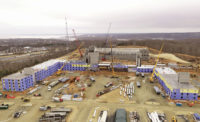Companies participating in the 2019 ENR MidAtlantic Top Design Firms survey continue to flourish. The 115 ranked firms saw their combined regional revenue from work performed and billed in 2018 hit $5.9 billion. That compares with $5.3 billion in work performed by 114 firms in 2017. Results reflect projects in Delaware, Maryland, Pennsylvania, Virginia, Washington, D.C., and West Virginia. The top 10 firms on the list had a strong year. After seeing their combined 2017 regional revenue decline 25%, to $2.1 billion from the year-earlier level, revenue rebounded in 2018, posting a gain of $800 million, or 38%.
No. 1 AECOM, a mainstay atop the MidAtlantic rankings, outpaced its 2017 revenue by 8.4%, to $690.83 million. No. 2 Michael Baker reported a 4.8% revenue decrease, to $218.72 million. Third-ranked Johnson, Mirmiran & Thompson Inc. posted a 7.7% gain, to $212.65 million.
“There’s a lot of good work out there currently and we’re seeing it in all sectors that we work in.”
– Joseph Makar, Administrative Partner, Whitman, Requardt & Associates LLP
No. 4-ranked Stantec moved up one slot from last year as revenue rose 13%, to $183.30 million. Brian Larson, Stantec senior vice president and U.S. East geographic leader, says the firm is experiencing strong results this year. “Utilization is high and growth is steady, with 2019 revenue so far outpacing where we were this time last year,” he says. Year over year, the firm’s revenue and backlog are up 20%. “Our staff count in the region has also increased, contributing to our 7% organic growth,” Larson adds.
Stantec’s largest project to break ground in 2018 was the $60-million University of Pittsburgh Medical Center Pinnacle Ambulatory Care Building in York, Pa. The firm’s environmental services and transportation teams also “have been particularly busy in response to increased demands for infrastructure work and the ongoing growth of the renewable energy market, which remains strong across the U.S.,” Larson says.
Whitman, Requardt & Associates LLP (WRA) slid one spot in the overall ranking to No. 10, but its regional revenue increased about 1% to $142.58 million. WRA ranks second in public building work, with $25.92 million. It recently completed an 86,000-sq-ft renovation project at the National Computing Center at the Social Security Administration headquarters in Woodlawn, Md.
Joseph Makar, administrative partner at WRA, describes the overall market as “phenomenal” and “plentiful.” He adds, “There’s a lot of good work out there currently and we’re seeing it in all sectors that we work in.”
|
Related Link |
Transportation Matters
More than 30 firms on the 2019 survey listed transportation as one of their leading sectors, and 75 firms combined to record a total of $2.06 billion in transportation work in 2018.
WRA, No. 7 in regional transportation revenue, recently entered into a program-management team with WSP and RS&H to conduct and develop solicitation documents for what could be the nation’s largest transportation public-private partnership. The proposed Interstate-495 and I-270 P3‚ whose cost could reach $11 billion, includes toll lanes and expansion of more than 70 miles of Maryland interstate, according to the Maryland Dept. of Transportation State Highway Administration. Earlier this month, Maryland’s Board of Public Works certified the proposal as a P3, as is required by state law, but decided to delay the I-495 portion of the project. The vote allows MDOT to begin vetting firms to enter into the P3.
Makar says transportation work is “booming” but is uncertain whether all of the funding for regional projects will stay in place. He says that some states seem to be well funded, but with other states, “We’ll see what happens.” The Virginia General Assembly, for example, recently approved funding for approximately $150 million in improvements to the 325-mile I-81 corridor. But it has been unsuccessful so far in securing additional federal funding. The Virginia Dept. of Transportation says the corridor needs $2 billion in upgrades.
The federal infrastructure picture is unclear after President Trump abruptly ended discussions with top congressional Democrats over a $2-trillion proposal. WRA’s Makar says, “Everybody in the political arena understands the importance of infrastructure, but I think they’re struggling in collaborating and negotiating to get a good bill through. I hope something does come through because there’s definitely a need for it.”
Stantec’s Larson—whose firm is providing engineering and design services on the $40-million Edmondson Avenue Bridge Replacement in Baltimore—says if the federal infrastructure measure “is not funded before the election cycle, we might expect a correction in the sector.”
Challenges Ahead
Although the MidAtlantic design and construction market is strong, labor costs and possible Trump administration-imposed tariffs on imported construction materials are creating uncertainty. Tim Burkett, director of operations at No. 54 Ayers Saint Gross says that some clients are considering renovations of their current buildings instead of new construction “to stand their ground and, in some cases, remain viable in an increasingly competitive landscape.”
Despite uncertain materials costs, Burkett says an increasing number of MidAtlantic owners are investing in resilient programs, such as the Living Building Challenge. “We’re starting to see clients look beyond sustainability for their campuses and look toward resilience and regenerative and or restorative designs and practices,” says Burkett, whose firm designed the nearly completed Semans Griswold Environmental Hall at Washington College in Chestertown, Md. “Buildings are increasingly appreciated for their actual performance metrics in lieu of predicted or potential savings.”
Burkett doesn’t anticipate a slowdown in requests for proposals and capital project planning in the next few years. But he is “leery of market volatility and long-term demographic changes impacting our markets beyond two years. As such, our business plan factors net revenue growth, but relies on a conservative model for establishing our overhead cost structure.”








Post a comment to this article
Report Abusive Comment